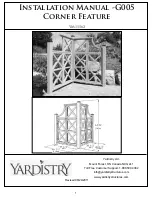
STRAIGHTENING INSTRUCTIONS
Instructions for straightening the luff:
Note: laying the luff on the ground with weights will not work
but will form kinks instead and also void the warranty.
1) With approximately one person every 8 feet, recoil the luff
in the opposite direction
2) Tape the end of the curved side to the straight side
3) Lay the luff on the ground for at least 3 hours
4) After that time, test to see if it has straightened out
5) If not, repeat the same process. Warmer temperatures will
help to speed up the straightening
6) The luff can have a slight bend to it, the headstay tension
will eventually straighten it out
ASSEMBLY INSTRUCTIONS
Assembly can be done with the mast up but is easiest to do
with the mast down.
1. Measure the length of your headstay from pin-to-pin with
your turnbuckle in its normal setting. If the mast is up, raise a
measuring tape attached to the jib halyard to the top of the
mast and add the length to the top pin on the headstay.
2. With this measurement, deduct 17” and cut the top of the
luff using a saw.
Do not cut end with the sail-feed slot.
The following is for FF4 systems, FF6 systems follow 3.B)
3. A) Take the halyard top
fitting and push the cored
end of the halyard (
without
the metal ferrule) up
through the bottom of the
off-center hole, not in the
center. Push the halyard
over the sheave and out the
side of the top fitting.
4. A) Using the de-cored
(hollow) end of the halyard
with the metal ferrule, pass
the ferrule down through the
slot at the top of the luff
extrusion on the opposite end
of the sail feed slot. Trimming
the halyard to the correct
length will happen once the
entire furler is setup.
The following is for FF6 systems, FF4 systems follow 3. A)
3. B) Take the halyard top fitting and push the exposed wire
on the halyard up through the bottom of the off-center hole,
not in the center. Push the halyard over the sheave and out
the side of the top fitting.
4. B) Using metal traveler on the wire halyard, pass the
traveler down through the slot at the top of the luff extrusion
on the opposite end of the sail feed slot. Trimming the
halyard and crimping the end will happen once the entire
furler is setup.
5. Attach the halyard top fitting to the luff, ensuring that the
side with the halyard coming through the fitting is on the
same side as the sail feed slot on the bottom of the luff.
Tighten the set screw so it firmly presses against the luff.
























